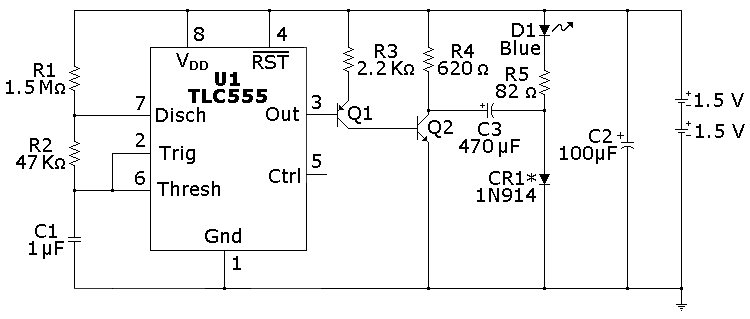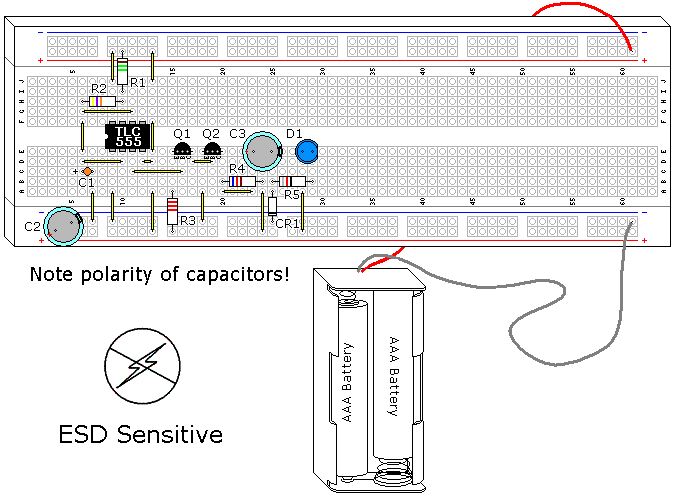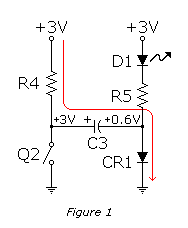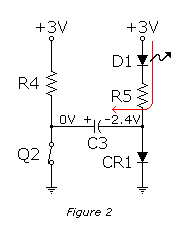8.6: CMOS 555 Long Duration Blue LED Flasher
- Page ID
- 1290
\( \newcommand{\vecs}[1]{\overset { \scriptstyle \rightharpoonup} {\mathbf{#1}} } \)
\( \newcommand{\vecd}[1]{\overset{-\!-\!\rightharpoonup}{\vphantom{a}\smash {#1}}} \)
\( \newcommand{\id}{\mathrm{id}}\) \( \newcommand{\Span}{\mathrm{span}}\)
( \newcommand{\kernel}{\mathrm{null}\,}\) \( \newcommand{\range}{\mathrm{range}\,}\)
\( \newcommand{\RealPart}{\mathrm{Re}}\) \( \newcommand{\ImaginaryPart}{\mathrm{Im}}\)
\( \newcommand{\Argument}{\mathrm{Arg}}\) \( \newcommand{\norm}[1]{\| #1 \|}\)
\( \newcommand{\inner}[2]{\langle #1, #2 \rangle}\)
\( \newcommand{\Span}{\mathrm{span}}\)
\( \newcommand{\id}{\mathrm{id}}\)
\( \newcommand{\Span}{\mathrm{span}}\)
\( \newcommand{\kernel}{\mathrm{null}\,}\)
\( \newcommand{\range}{\mathrm{range}\,}\)
\( \newcommand{\RealPart}{\mathrm{Re}}\)
\( \newcommand{\ImaginaryPart}{\mathrm{Im}}\)
\( \newcommand{\Argument}{\mathrm{Arg}}\)
\( \newcommand{\norm}[1]{\| #1 \|}\)
\( \newcommand{\inner}[2]{\langle #1, #2 \rangle}\)
\( \newcommand{\Span}{\mathrm{span}}\) \( \newcommand{\AA}{\unicode[.8,0]{x212B}}\)
\( \newcommand{\vectorA}[1]{\vec{#1}} % arrow\)
\( \newcommand{\vectorAt}[1]{\vec{\text{#1}}} % arrow\)
\( \newcommand{\vectorB}[1]{\overset { \scriptstyle \rightharpoonup} {\mathbf{#1}} } \)
\( \newcommand{\vectorC}[1]{\textbf{#1}} \)
\( \newcommand{\vectorD}[1]{\overrightarrow{#1}} \)
\( \newcommand{\vectorDt}[1]{\overrightarrow{\text{#1}}} \)
\( \newcommand{\vectE}[1]{\overset{-\!-\!\rightharpoonup}{\vphantom{a}\smash{\mathbf {#1}}}} \)
\( \newcommand{\vecs}[1]{\overset { \scriptstyle \rightharpoonup} {\mathbf{#1}} } \)
\( \newcommand{\vecd}[1]{\overset{-\!-\!\rightharpoonup}{\vphantom{a}\smash {#1}}} \)
\(\newcommand{\avec}{\mathbf a}\) \(\newcommand{\bvec}{\mathbf b}\) \(\newcommand{\cvec}{\mathbf c}\) \(\newcommand{\dvec}{\mathbf d}\) \(\newcommand{\dtil}{\widetilde{\mathbf d}}\) \(\newcommand{\evec}{\mathbf e}\) \(\newcommand{\fvec}{\mathbf f}\) \(\newcommand{\nvec}{\mathbf n}\) \(\newcommand{\pvec}{\mathbf p}\) \(\newcommand{\qvec}{\mathbf q}\) \(\newcommand{\svec}{\mathbf s}\) \(\newcommand{\tvec}{\mathbf t}\) \(\newcommand{\uvec}{\mathbf u}\) \(\newcommand{\vvec}{\mathbf v}\) \(\newcommand{\wvec}{\mathbf w}\) \(\newcommand{\xvec}{\mathbf x}\) \(\newcommand{\yvec}{\mathbf y}\) \(\newcommand{\zvec}{\mathbf z}\) \(\newcommand{\rvec}{\mathbf r}\) \(\newcommand{\mvec}{\mathbf m}\) \(\newcommand{\zerovec}{\mathbf 0}\) \(\newcommand{\onevec}{\mathbf 1}\) \(\newcommand{\real}{\mathbb R}\) \(\newcommand{\twovec}[2]{\left[\begin{array}{r}#1 \\ #2 \end{array}\right]}\) \(\newcommand{\ctwovec}[2]{\left[\begin{array}{c}#1 \\ #2 \end{array}\right]}\) \(\newcommand{\threevec}[3]{\left[\begin{array}{r}#1 \\ #2 \\ #3 \end{array}\right]}\) \(\newcommand{\cthreevec}[3]{\left[\begin{array}{c}#1 \\ #2 \\ #3 \end{array}\right]}\) \(\newcommand{\fourvec}[4]{\left[\begin{array}{r}#1 \\ #2 \\ #3 \\ #4 \end{array}\right]}\) \(\newcommand{\cfourvec}[4]{\left[\begin{array}{c}#1 \\ #2 \\ #3 \\ #4 \end{array}\right]}\) \(\newcommand{\fivevec}[5]{\left[\begin{array}{r}#1 \\ #2 \\ #3 \\ #4 \\ #5 \\ \end{array}\right]}\) \(\newcommand{\cfivevec}[5]{\left[\begin{array}{c}#1 \\ #2 \\ #3 \\ #4 \\ #5 \\ \end{array}\right]}\) \(\newcommand{\mattwo}[4]{\left[\begin{array}{rr}#1 \amp #2 \\ #3 \amp #4 \\ \end{array}\right]}\) \(\newcommand{\laspan}[1]{\text{Span}\{#1\}}\) \(\newcommand{\bcal}{\cal B}\) \(\newcommand{\ccal}{\cal C}\) \(\newcommand{\scal}{\cal S}\) \(\newcommand{\wcal}{\cal W}\) \(\newcommand{\ecal}{\cal E}\) \(\newcommand{\coords}[2]{\left\{#1\right\}_{#2}}\) \(\newcommand{\gray}[1]{\color{gray}{#1}}\) \(\newcommand{\lgray}[1]{\color{lightgray}{#1}}\) \(\newcommand{\rank}{\operatorname{rank}}\) \(\newcommand{\row}{\text{Row}}\) \(\newcommand{\col}{\text{Col}}\) \(\renewcommand{\row}{\text{Row}}\) \(\newcommand{\nul}{\text{Nul}}\) \(\newcommand{\var}{\text{Var}}\) \(\newcommand{\corr}{\text{corr}}\) \(\newcommand{\len}[1]{\left|#1\right|}\) \(\newcommand{\bbar}{\overline{\bvec}}\) \(\newcommand{\bhat}{\widehat{\bvec}}\) \(\newcommand{\bperp}{\bvec^\perp}\) \(\newcommand{\xhat}{\widehat{\xvec}}\) \(\newcommand{\vhat}{\widehat{\vvec}}\) \(\newcommand{\uhat}{\widehat{\uvec}}\) \(\newcommand{\what}{\widehat{\wvec}}\) \(\newcommand{\Sighat}{\widehat{\Sigma}}\) \(\newcommand{\lt}{<}\) \(\newcommand{\gt}{>}\) \(\newcommand{\amp}{&}\) \(\definecolor{fillinmathshade}{gray}{0.9}\)PARTS AND MATERIALS
- Two AAA Batteries
- Battery Clip (Radio Shack catalog # 270-398B)
- U1 - 1CMOS TLC555 timer IC (Radio Shack catalog # 276-1718 or equivalent)
- Q1 - 2N3906 PNP Transistor (Radio Shack catalog #276-1604 (15 pack) or equivalent)
- Q2 - 2N2222 NPN Transistor (Radio Shack catalog #276-1617 (15 pack) or equivalent)
- CR1 - 1N914 Diode (Radio Shack catalog #276-1122 (10 pack) or equivalent, see Instructions)
- D1 - Blue light-emitting diode (Radio Shack catalog # 276-311 or equivalent)
- R1 - 1.5 MΩ 1/4W 5% Resistor
- R2 - 47 KΩ 1/4W 5% Resistor
- R3 - 2.2 KΩ 1/4W 5% Resistor
- R4 - 620 Ω 1/4W 5% Resistor
- R5 - 82 Ω 1/4W 5% Resistor
- C1 - 1 µF Tantalum Capacitor (Radio Shack catalog 272-1025 or equivalent)
- C2 - 100 µF Electrolytic Capacitor (Radio Shack catalog 272-1028 or equivalent)
- C3 - 470 µF Electrolytic Capacitor (Radio Shack catalog 272-1030 or equivalent)
CROSS-REFERENCES
Lessons In Electric Circuits, Volume 1, chapter 16: “Voltage and current calculations“
Lessons In Electric Circuits, Volume 1, chapter 16: “Solving for unknown time”
Lessons In Electric Circuits, Volume 3, chapter 4 : “Bipolar Junction Transistors”
Lessons In Electric Circuits, Volume 3, chapter 9 : “ElectroStatic Discharge”
Lessons In Electric Circuits, Volume 4, chapter 10: “Multivibrators”
LEARNING OBJECTIVES
- Learn a practical application for a RC time constant
- Learn one of several 555 timer Astable Multivibrator Configurations
- Working knowledge of duty cycle
- How to handle ESD sensitive parts
- How to use transistors to improve current gain
- How to use a capacitor to double voltage with a switch
SCHEMATIC DIAGRAM

ILLUSTRATION

INSTRUCTIONS
NOTE! This project uses a static sensitive part, the CMOS 555. If you do not use protection as described in Volume 3, Chapter 9, ElectroStatic Discharge, you run the risk of destroying it.
This circuit builds on the previous two experiments, using their features and adding to them. Blue and white LEDs have a higher Vf (forward dropping voltage) than most, around 3.6V. 3V batteries can’t drive them without help, so extra circuitry is required.
As in the previous circuits, the LED is given a 0.03 second (30ms) pulse. C3 is used to double the voltage of this pulse, but it can only do this for a short time. Measuring the current though the LED is impractical with this circuit because of this short duration, but blue LEDs are generally more predictable because they were invented later.
This particular design can also be used with a single 1 1/2V battery. The base concept was created with a now obsolete IC, the LM3909, which used a red LED, the IC, and a capacitor. As with this circuit, it could flash a red LED for over a year with a single D cell. When newer red LEDs increased their Vf from 1.5V to 2.5V this old chip was no longer practical, and is still missed by many hobbyists. If you want to try a 11/2V battery change R5 to 10Ω and use a red LED with a better CR1 (see next paragraph) .
CR1 is not the best choice for this component, it was selected because it is a common part and it works. Almost any diode will work in this application. Schottky and germanium diodes drop much less voltage, a silicon diode drops 0.6-0.7V, while a Schottky diode drops 0.1-0.2V, and a germanium diode drops 0.2V-0.3V. If these components are used the reduced voltage drop would translate into brighter LED intensity, as the circuits efficiency is increased.
THEORY OF OPERATION
Q2 is a switch, which this circuit uses. When Q2 is off C3 is charged to the battery voltage, minus the diode drop, as shown in Figure 1. Since the blue LED Vf is 3.4V to 3.6V it is effectively out of the circuit.

Figure 2 shows what happens when Q2 turns on. The capacitor C3 + side is grounded, which moves the - side to -2.4V. The diode CR1 is now back biased, and is out of the circuit. The -2.4V is discharged through R5 and D1 to the +3.0V of the batteries. The 5.4V provides lots of extra voltage to light the blue LED. Long before C3 is discharged the circuit switches back and C3 starts charging again.

In the LM3909 CR1 was a resistor. The diode was used to minimize current, by allowing R4 to be its maximum value.
You may notice a dim blue glow in the blue LED when it is off. This demonstrates the difference between theory and practice, 3V is enough to cause some leakage through the blue LED, even though it is not conducting. If you were to measure this current it would be very small.


